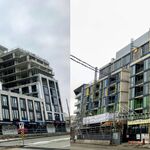diminutive
Active Member
^
That report is kind of bizarre. I'm not sure what to make of it.
"A staggering number of people own their homes, but spend more than a third of their income on their housing costs"
This is just a GTA-wide affordability issue. It's not Vaughan specific. Housing affordability is a major regional issue.
"Because people spend so much time working, they have less time to get involved in their community or little desire to engage in local politics."
Again, not so sure this has anything to do with Vaughan. Canadians work long hours by OECD standards, which is a at least partially a product of low productivity.
"Vaughan residents spend a lot of time driving rather than transit, and feel the lifestyle has a negative impact on their health"
Duh...
And the policy recommendations are just asinine: "The report has four policy recommendations for consideration: increasing affordable housing, increase access to affordable public transportation, encouraging policies which improve air quality, and finding ways to promote the local economy. "
What jurisdiction in the world doesn't try to "promote the local economy?" That's no more of a policy recommendation that 'winning' is a sports strategy.
That report is kind of bizarre. I'm not sure what to make of it.
"A staggering number of people own their homes, but spend more than a third of their income on their housing costs"
This is just a GTA-wide affordability issue. It's not Vaughan specific. Housing affordability is a major regional issue.
"Because people spend so much time working, they have less time to get involved in their community or little desire to engage in local politics."
Again, not so sure this has anything to do with Vaughan. Canadians work long hours by OECD standards, which is a at least partially a product of low productivity.
"Vaughan residents spend a lot of time driving rather than transit, and feel the lifestyle has a negative impact on their health"
Duh...
And the policy recommendations are just asinine: "The report has four policy recommendations for consideration: increasing affordable housing, increase access to affordable public transportation, encouraging policies which improve air quality, and finding ways to promote the local economy. "
What jurisdiction in the world doesn't try to "promote the local economy?" That's no more of a policy recommendation that 'winning' is a sports strategy.




